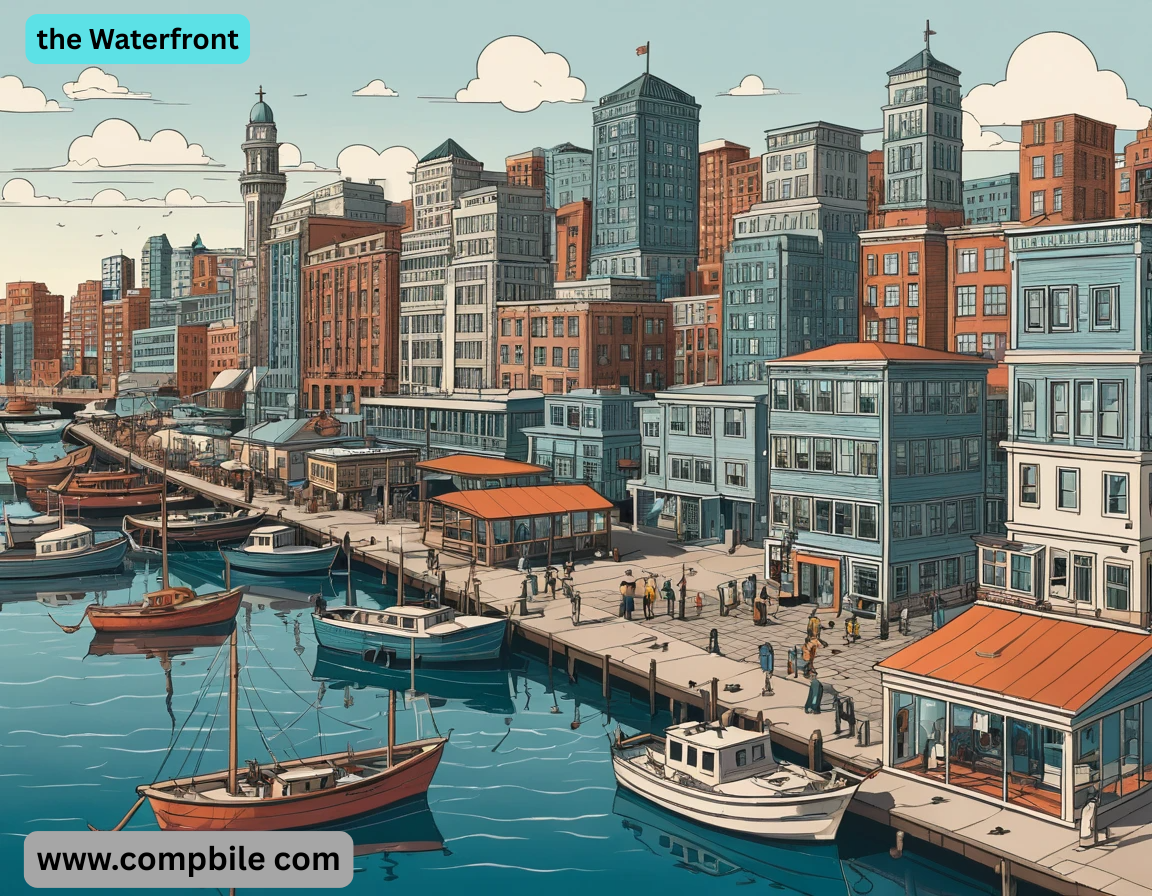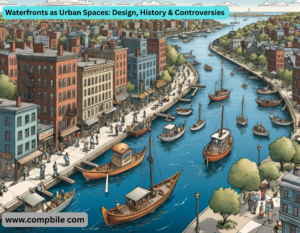the Waterfront “The Waterfront” can refer to several different things depending on the context. Here are some common interpretations:
- Waterfront as a Geographic Area – A waterfront is a part of a city or town that borders a body of water, such as a river, lake, or ocean. These areas are often developed for recreational, commercial, or residential purposes (e.g., San Francisco’s waterfront, Toronto’s waterfront).
- The Waterfront (Film) – On the Waterfront (1954) is a classic American film directed by Elia Kazan, starring Marlon Brando. It deals with corruption in dockyards and won multiple Academy Awards.
- Music & Entertainment – “Waterfront” is also a song by Simple Minds (1983) and has been used in various albums and performances.
- Restaurants & Businesses – Many establishments use “Waterfront” in their names, such as hotels, restaurants, and event venues located near water.
- Real Estate & Property Development – Waterfront properties are highly valued for their views and access to water activities.
Waterfront as a Place Urban Development & Tourism
- Many cities have iconic waterfronts that serve as cultural, economic, and recreational hubs. Examples include:
- Cape Town Waterfront (V&A Waterfront, South Africa) – A bustling harbor with shops, museums, and Table Mountain views.
- Sydney HARBOUR (Australia) – Home to the Opera House, HARBOUR Bridge, and scenic walks.
Why are waterfronts important?
- Boost tourism and local businesses.
- Often include mixed-use spaces (dining, shopping, housing).
- Environmental efforts to restore ecosystems (e.g., Boston’s “Harbor walk”).
On the Waterfront 1954 Film
- Director: Elia Kazan
- Starring: Marlon Brando, Eva Marie Saint, Karl Malden
- Plot: A former boxer (Terry Malloy) confronts union corruption on the docks of Hoboken, NJ.
- Famous Line: “I coulda been a contender.”
- Awards: Won 8 Oscars, including Best Picture and Best Actor (Brando).
- Legacy: A critique of labor exploitation and McCarthy-era politics.
Music Waterfront by Simple Minds 1983
- Lyrics evoke imagery of docks and industrial landscapes.
- Later remixed for dance floors and used in films/TV.
Waterfront Properties & Real Estate
- High demand for homes, hotels, or offices with water views.
- Challenges: Climate change (rising sea levels), zoning laws.
- Examples: Miami Beach, Dubai Marina, Amsterdam’s canals.
Waterfronts in Pop Culture
- Games: Grand Theft Auto IV features a fictional waterfront inspired by NYC.
- Literature: The Waterfront by Herman Wouk (a novel about labor struggles).
- Art: Famous paintings like Monet’s Waterloo Bridge series.
Waterfronts as Urban Spaces Design, History & Controversies
Engineering & Architecture
- Land Reclamation: Many waterfronts (e.g., Tokyo Bay, Dubai) are built on artificial land. Boston’s waterfront expanded by filling in marshes in the 1800s.
Iconic Structures:
- London’s Thames Barrier – Protects the city from flooding; a feat of 1980s engineering.
Failed Projects:
- Sydney’s Barangaroo – Criticized for overdevelopment and blocking public views.
- Porto Maravilha (Rio de Janeiro) – Promised revitalization but displaced favela residents.
Gentrification & Conflict
- San Francisco’s Embarcadero: Once a gritty port, now a tech-money hotspot—sparking debates about erased working-class history.
- Baltimore’s Inner Harbor: Revival succeeded, but nearby neighborhoods remain impoverished.
On the Waterfront 1954 Untold Stories
Real-Life Inspirations
- Based on Malcolm Johnson’s Pulitzer-winning exposé (1948) about NYC dockworker unions tied to the mafia.
- The film parallels the murder of longshoreman Pete PQANTO, who spoke out against corruption.
Behind the Scenes
- Marlon Brando’s ad-libs: The “contender” speech was partly improvised.
- Kazan’s Controversy: He was criticized for naming names during the McCarthy-era Hollywood Blacklist, which some say mirrors the film’s themes of betrayal.
- Deleted Subplot: A romance between Terry (Brando) and a nun was cut for being “too controversial.”
Cultural Impact
- Homages: The Sopranos (S6E13) recreates the taxi scene with Tony Soprano.
Waterfront Music & Art
Songs Named “Waterfront”
- Simple Minds (1983): Inspired by industrial docks in Glasgow.
- Pete Seeger: Folk songs about Hudson River labor struggles.
Paintings & Photography
- Bernd & HILLA Becher: German photographers known for stark waterfront industrial shots.
Waterfront Real Estate Extreme Examples
Most Expensive:
- Monaco’s Lar VOTTO Beach – Apartments sell for $100M+.
- Hong Kong’s Victoria HARBOUR – Costs $11,000/SQ ft.
Most Remote:
- Tofino, Canada – Surf shacks on the Pacific edge.
- Ushuaia, Argentina – “End of the world” waterfronts.
Waterfront Disasters & Ecological Crises
- Love Canal (NY): A 1970s toxic waste scandal near the Niagara River.
- Flint Water Crisis (Michigan): Contaminated river water poisoned a city.
- Venice Sinking: Rising seas threaten historic canals.
Obscure Pop Culture Waterfronts
Video Games:
- Disco Elysium – A dystopian harbor city.
- BioShock – Underwater “Rapture” as a failed utopia.
Books:
- The Waterfront by B. Traven (1940s labor novel).
- Dock Life – Photography books capturing sailor subcultures.
Waterfronts Hidden Histories & Lost Eras
Pre-Industrial Waterfronts: When Docks Were W
- Medieval London: The Thames was lined with “stink stairs”—wooden steps where butchers dumped offal into the river.
- Shanghai, 1800s: The “Blood Alley” waterfront was a lawless zone of opium dens and gang wars between British and Triad factions.
Abandoned Waterfronts: Ghost Ports of the World
- Pripyat River Port (Chernobyl): A frozen-in-time Soviet dock, meant to serve a city that no longer exists.
- HASHIMA Island (Japan): A Battleship Island coal-mining port abandoned in 1974, now a UNESCO ruin.
- Detroit’s Zug Island: A post-industrial wasteland where the Rouge River meets the Great Lakes, once the heart of auto industry shipping.
On the Waterfront The Deep Cut Lore
The Real Mobsters Behind the Movie
- The film’s villain, Johnny Friendly, was based on Albert Anastasia, head of Murder Inc., who controlled NYC docks.
- The “D & D” Diner Scene: The real-life Lindy’s Diner in Hoboken was a known mob meeting spot—Brando ate there during filming.
- The Rat Symbolism: The famous “I was a rat” line was a direct jab at Kazan’s HUAC testimony, where he “ratted” on communist colleagues.
Alternate Endings & Lost Footage
- Original Script: Terry Malloy was supposed to die in the hold of a ship, but test audiences hated it.
- Deleted Character: A corrupt priest (cut for being too anti-clerical).
- Brando’s Unused Monologue: A 10-minute rant about working-class despair, cut for pacing.
The Film’s Secret Influence
- Inspired Nirvana’s “Something in the Way” (Kurt Cobain identified with Terry Malloy’s outcast role).
- Stanley Kubrick called it “the most perfect film ever made”—he stole the long-take fight scenes for Barry Lyndon.
Waterfronts in War & Espionage
WWII’s Secret Waterfront Ops
- Operation Mincemeat (1943): A corpse with fake intel was dumped off Spain’s coast to mislead Nazis.
- NYC’s Black Tom Explosion (1916): German saboteurs blew up a Jersey City arms dock, shattering windows in Manhattan.
Cold War Waterfronts
- Hamburg’s St. Pauli Docks: A hotspot for spy exchanges between Stasi and CIA agents.
- Vladivostok, USSR: A closed military port where Soviet subs lurked—now a gambling hub for Chinese tourists.
Get article on pdf file…Click now




